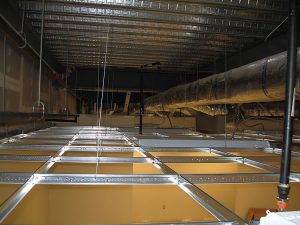Passing an Above-Grid Ceiling Inspection
By: JADE Learning | Dec 29, 2014
The most stressful time for any project is when it is nearing completion and the drop dead date is approaching. This is usually the time that the grid ceiling is being installed. When this is happening, there will be several trades that can’t proceed without the other trade being finished and out of the way. There is no time for a failed above-grid electrical inspection.
Here are the 6 most common violations that inspectors see in an above-grid ceiling inspection:
- Ceiling tiles already installed. This is a big mistake made by the general contractor rather than the electrician. Never allow the ceiling tiles to be installed without asking the inspector first.
- Electrical boxes still open. Remember, since this could be the last time the inspector will see above the ceiling, the inspector wants to see that all boxes and openings are closed per NEC 110.12(A). Some contractors aren’t sure if the inspector wants all boxes open for the inspection. A good rule of thumb is to close everything and be ready in case the inspector points out a specific box that he wants to see inside.
- Insufficient working space for above ceiling HVAC disconnect switches. The 2014 NEC change to 424.66(B) has made the requirements for clear work space around duct heaters tougher. Now the width of the work space must be at least 30 inches, all doors and hinged panels must open at least 90 degrees and depth of work space must comply with Table 110.26(A)(1). In the crowded space above a suspended ceiling, it can be difficult to meet these new requirements for working space around duct heaters.
- Wiring not plenum rated. Not all above ceiling spaces are considered a plenum. If the return air for the above ceiling HVAC unit is not ducted directly to the grid ceiling and it is pulled through a ceiling register with no duct work then the space is being used as a plenum or for environmental air. In these areas metal wiring methods are required per NEC 300.22(C). Low voltage cables including Cat 5, CATV, and alarm wiring will need to be plenum rated as well. Most plenum rated low voltage cables will have the letter “P” as part of the cable designation. CMP, CL2P, CL3P are all plenum rated cables.
- Luminaires not secured to the grid. Section 410.36(B) requires luminaires to be fastened to the grid ceiling with screws or listed clips. Many lay-in lights have factory clips that simply fold over and lock on to the grid. Check the luminaire installation instructions. These clips are listed but only “when properly installed”. Many Inspectors will not accept them because most often, the ceiling tile installer will fold them back over out of his way as he is installing the ceiling tiles. This is not considered properly installed.
- Securing/supporting wiring methods. Section 330.30 requires MC cable to be fastened within 12 inches of each box and at 6 foot intervals. Section 358.30 requires EMT to be fastened within 3 feet of each box and at 10 foot intervals. Section 348.30 requires FMC to be fastened within 12 inches of each box and at 4.5 foot intervals.



Thank you for this information; it is beneficial.
Do you tie the mc support wire to the ceiling grid?
I just had inspection today and our inspector had us tie our own wires securing our Mc to the ceiling grit. First time this happens. It’s usually the other way around
Who takes precedence?
Electrical inspector
City inspector.
Can you tie mc wire to the ceiling grid?
Ya the electrical ceiling grid wire has to be Identified Is and fastened to the ceiling with listed clips . Then you could hang you.r MC on it. I never hang my MC on a ceiling grid support wire that’s designated for the ceiling grid